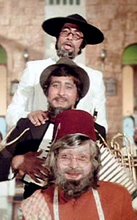We discussed the
greatest economists of all time last September, settling for, in chronological order: Adam Smith, David Ricardo, Karl Marx, Alfred Marshall, John Maynard Keynes, Ronald Coase, Paul Samuelson, Kenneth Arrow, Milton Friedman, and Garry Becker. Now, these guys are all old, really old, they all remember the Great Depression. Who are the greatest economists born after World War II?
That’s the question the Economist asked in an issue in the late 1980s. They settled for eight people. They are listed below, in alphabetical order, with brief notes on where they are now.
• Alberto Alesina: works on political economy and co-authors fascinating books such as the one discussed
here.
• Sanford Grossman: a very wealthy fellow with his own
hedge fund.
• Paul Krugman: easily the best known of the eight, as much for his widely partisan New York Times columns as for his work in international trade and finance; might win a Nobel, perhaps with
Bhagwati.
• Gregory Mankiw: served the Bush administration, sold heaps of textbooks, and has his own
blog.
• Jeffrey Sachs: after providing shock therapy to countries from Bolivia to Bulgaria,
Sachs has been saving the world with U2’s Bono for the past few years.
• Andrei Shleifer: he advised ex-communists on how to get into capitalism before getting into legal wrangles with the US government, ironically as his research issue is corruption.
• Larry Summers: after serving as the Secretary of Treasury during the last years of the Clinton Administration, he ran Harvard for five years before quitting over
women.
• Jean Tirole: the only one in the list to be based outside the United States, and the only one to have remained in the ivory tower, working on
microeconomic theory.
A decade later, the magazine asked
Où sont les Krugmans d’antan? They came up with a list of another eight bright and coming economists. They are listed below, in the order of their appearance in the Economist piece, with brief notes on their specialty and what they have been up to since then.
• Michael Kremer: then of MIT, now at Harvard, Kremer was chosen for his
O-ring theory, and it seems a decade on, this is still his best known work.
• Edward Glaeser: of Harvard, chosen by the Economist for his work on why cities exist, he has been a prolific researcher exploring, among other things, Rove’s
excite the base strategy, the need for
state sanctioned holidays, co-authoring the abovementioned book with Alesina and much, much more.
• Casey Mulligan: he was chosen for the observation that social factors, such as parents’ work ethic, contribute far more to inequality than financial constraints do; he continues to be a prolific ivory tower economist at Chicago.
• Steve Levitt: he was chosen for innovative empirical works like the one that drew a link between the legalisation of abortion in the 1970s and the drop of crime rates in the 1990s; since then, he has won the
John Bates Clark medal in 2003 and written
Freakonomics.
• Caroline Hoxby: of Harvard, chosen for, and continues to work on, the economics of education.
• Glenn Ellison: of MIT, continues to work on microeconomic theory.
• Wolfgang Pesendorfer: of Princeton, works on game theory and political economy.
• Matthew Rabin: of Berkeley, works on behavioural economics, and won the
John Bates Clark medal in 2001.
Two people not in the list have won the John Bates Clark medal, awarded to ‘that American economist under the age of forty who is adjudged to have made a significant contribution to economic thought and knowledge’ by the American Economic Association and is considered the best accolade in the profession, in recent years. They are: MIT’s Daron Acemoglu, co-author of a great read on
democracy and dictatorship, and Harvard’s Susan Athey, who works on auction theory, proving that theory is not dead.
This then raises the obvious question, who are the brightest of today’s economists? I guess there will be an article in the 2008 Christmas edition.













